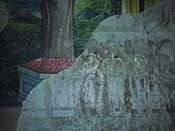Paramakanda Raja Maha Vihara
| Paramakanda Raja Maha Vihara පරමාකන්ද රජ මහා විහාරය | |
|---|---|
 | |
| Basic information | |
| Location | Anamaduwa, Sri Lanka |
| Geographic coordinates | 07°55′N 80°00′E / 7.917°N 80.000°ECoordinates: 07°55′N 80°00′E / 7.917°N 80.000°E |
| Affiliation | Buddhism |
| District | Puttalam |
| Province | North Western Province |
| Heritage designation | Archaeological protected monument[1] (1 November 1996) |
| Architectural description | |
| Architectural type | Buddhist Temple |
| Architectural style | Cave temple |
| Founder | King Walagamba |
Paramakanda Raja Maha Vihara is an ancient Buddhist temple and a monastery within a cave located in Anamaduwa, Puttalam District, Sri Lanka. The temple site is situated 105 km (65 mi) from the Kurunegala town.[2] This temple is a protected archaeological site within Sri Lanka.[1]
History

It's believed that Paramakanda temple was constructed by King Walagamba in 89 - 77 BC.[3] According to the rock inscription at Thonigala, this temple was built by a priest named Mahatissa Thero, during the reign of King Walagamba.[4]
The Temple
The Vihara complex mainly consists of two compounds. At the ground level, the temple has a large number of cave and shrine rooms under the overhanging rock.
Upper rock
A small image house and a carved foot print of Buddha (Sri Pathla) can be seen at the upper rock site.[5]
Paintings


Both Kandyan era paintings and modern paintings can be seen in the clay made image house. New Paintings were painted over old paintings, but due to the new layer crumbling off, the old paintings have re-emerged. Other images and statues in the mansion show features of the Kandyan era.
Rock inscription
Two stone inscriptions can be seen at the Vihara premises. One of them is in front of the image house and other is near Vihara pond. The inscription at the pond was created in the 1st Century CE and composed with early Brahmin scripts, using the Sinhala language. This inscription mentions the cistern of Chief Daring Mariner, the son of Chief Abhaya.
See also
References
- 1 2 "Protercted Monument List 2012-12-12" (PDF). Department of Archaeology. 12 December 2012. Retrieved 27 March 2016.
- ↑ "Paramakanda Cave Temple Anamaduwa". srilankantravellers.com. 22 August 2011. Retrieved 19 July 2015.
- ↑ "Paramakanda". themudhouse. Retrieved 19 July 2015.
- ↑ "Paramakanda Cave Temple at Anamaduwa – ආනමඩුව පරමකන්ද රජමහා විහාරය". amazinglanka. 22 August 2011. Retrieved 19 July 2015.
- ↑ "Paramakanda Cave Temple". srisalike.com. Retrieved 19 July 2015.